Volume 1, Number 8 - Summer 1963
Report Of Annual Meeting
"Seven thousand years ago there was a race of people living on this piece of ground right where you are today." With this introduction, Mrs. Kenneth D. Ford began her report on the Indian artifacts found at the Yacht Club on Lake Taneycomo near the mouth of Turkey Creek in Hollister. Mr. and Mrs. Ford and their son, Kenneth, Jr., were hosts to the members of the White River Valley Historical Society at the annual meeting, June 30.To illustrate her talk, Mrs. Ford used the effective display prepared by her son showing artifacts from three periods: Mississippian, Woodland, and Archaic. She explained that the family's interest in artifacts goes back many years and, although they work as amateurs, the University of Missouri has assigned them a site number: 23TY250.
While they were digging a house foundation, they uncovered artifacts dating from about the time the white man came and going back several hundred years. They also found horseshoes, some handmade, and one casing from a bullet, the shell dating prior to 1893.
About 1830, James Wilson (for whom Wilson's Creek battleground was named) operated a trading post at the site, living with the Indians, and trading for deerskins and bearskins which he shipped to
[10]
St. Louis. He left the area about 1837.
The Mississippian was at a depth of some eighteen inches, and the Woodland, dating back about 1100 years, was found at 30-36 inches. This rich period was represented in the display by projectile points, knives, scrapers, and a fireplace which the Fords had dug out with spoons, carefully leaving the stones and charcoal undisturbed. The earth showed red streaks from the paint rocks. "We assume," said Mrs. Ford, "that the early Woodland was pre-pottery, since we have found no pottery at all." Also at that depth, they uncovered a grindstone which showed signs of having been used on both sides. Many of the artifacts were found very recently as they were digging a utility trench.
The third group, the Archaic dating back seven thousand years, also contained projectile points. Very different from the other two periods, Mrs. Ford said it was comparable to the Old Copper culture of Wisconsin. Between each layer of artifacts, they noted completely sterile soil. An especially interesting piece in the Archaic group was a nodule which had been broken, then chipped with a tool evidently to make a scraper of it.
Close by the west entrance of the club house, they had discovered traces of the old road leading to the White River ford. Chunks of the hardened soil, full of bits of rock and shell, still show evidence of wagonwheels which passed over it decades ago. The lake bank is still indented to mark the road going down to the ford which went across 'the river at an angle toward the Branson-Hollister bridge. The old ferry was above the ford a short distance.
Elmo Ingenthron complimented Mrs. Ford on her graphic presentation, and observed that these trips back in time could be recommended to anyone looking for an economical way to enjoy, himself since it's "a sight cheaper to live in the past than in the present."
The extensive research which Mr. Ingenthron has done on the history of this area provided additional information on the site where the members met. He referred to an ancient stream bed which once existed there, probably several hundred feet above the present elevation, and touched on the early historic Indians of this area
In discussing the mining boom of the 1880's and 90's around Turkey Creek, he noted that an early geological map showed a strip of land containing minerals reaching from about Lead Hill, Arkansas, to Turkey Creek and on to Roark Creek. About 1890, mines known as the Josie B. and the Silver Moon were located on Turkey Creek's Wolf Springs about five miles south of Kirbyville; the Bennett Mining Company was established on Turkey Creek, and the King Solomon mine was about four miles from the present-day Yacht Club.
When the Turkey Creek ferry was operating in the 1880's, the area east of this point on White River was much more heavily populated than the land west where Branson is now. Records show that from 1889-1893, Henry C. Berry and J. T. Berry were licensed by the County Court to operate the ferry; 1893-1899: William M. Hawkins and A. J. Hawkins were the operators; 1901: J. R. VanZandt; 1904-1905: Charles M. Thompson and William E. Cox; 1909: J. R. VanZandt. In 1913, the same year in which a bridge was built across the new Lake Taneycomo, William Fermin was granted the ferry license, and Mr. Ingenthron believes that he was the last operator since, after the bridge was built, the need for the ferry no longer existed. Usually the license fee was between $10 and $15, but from 1880-1903, there was no charge for the Turkey Creek ferry license since it was regarded as an accommodation ferry due to the sparsely settled land west of the river.
The County Court, in addition to granting ferry licenses, also set the fees for ferrying. They varied from time to time, but to cross a ferry in 1889 in Taney County it cost:
a wagon, 2 yokes of oxen or 4 horses 75cwagon, 1 yoke of oxen or 2 horses 50c
horse carriage and 1 horse 35c
man and horse 25c
cattle by the head 10c
sheep and hogs 5c
footman l0c
The ferry was used most during the construction of the railroad by the White River-Iron Mountain Company, 1903-1906. In 1905 the railroad was completed south to Branson, and trains were carrying posts, ties, cordwood and lumber to northern markets. The railroad had been completed north in Marion County, Arkansas, much earlier, and in 1906 the final link to Branson was completed so that through-trains could run. The railroad company is unable to give a specific date on the first through-train.
After Lake Taneycomo was formed in 1913, the area at the mouth of Turkey Creek became one of the favorite spots for swimming, boating and fishing.
In addition to the two speakers, Douglas Mahnkey, program chairman, arranged for Howard Lawrence, Kissee Mills, and Glen Bilyeu, Walnut Shade to bring their guitar, violin and banjo for an old-time music session. Mr. Mahnkey pointed out the importance of music to pioneer people, saying it was unlikely they could have progressed as they did without the musicians to help lift their spirits. "The Dusty Miller," "Cripple Creek," "Sally Gooden," "Red Wing," and "Black Mountain Rag" were among the tunes played as a part of the program and during the social hour which followed. Refreshments were provided by Mrs. Helen Awbery, Mrs. H. P. Patheal, and Albert Cummings.
Dr. R. M. Good presided at the business session, and Ralph D. McPherson of Forsyth was elected president for 1963-64. Other officers are Miss Frances McConkey, Forsyth, first vice-president; I. M. Thompson, Branson, second vice-president; Elmo Ingenthron, Kirbyville, secretary, and Mrs. Dorothy Standlee, Hollister, treasurer. New directors are Leon Farrell for Taney County, Missouri, and Mrs.
[11]
L. D. Burnes for Marion County, Arkansas. Mrs. Ruby Robins was re-elected director from Ozark County, Missouri Other directors are Mrs. Mary Scott Hair for Stone County, Missouri; Coy Logan for Carroll County, Arkansas; Claude Hibbard for Douglas County, Missouri; and Gene Geer for Christian County, Missouri.
The outgoing officers, Dr. Good, Robert L. Gideon, and Arch Mayden, earned the appreciation of the members for the time and effort and prestige they have given the Society during the past year. Under their leadership, the Society from June 1962 to June 1963 tripled in membership.
Another class of membership increased at the annual meeting with the election of honorary members. Five people were honored, three for their outstanding contributions to the preservation of local history, and two for their work on the Quarterly published by the Society. The Board of Directors nominated, and the members elected Coy Logan of Berryville, Arkansas; Senator J. E. Curry, Ava, Mis souri; Senator William E. Freeland, Forsyth, Missouri, for their contributions in preserving the early history of their respective counties. Elected for his work in publishing the Society's Quarterly was Leslie Brock, Point Lookout, Missouri. Also elected was the editor of the Quarterly, Dorothy Cummings, which led us to believe that the members got carried away and should have stopped their afternoon's work after they had honored Mr. Logan, Senator Curry, Senator Freeland, and Mr. Brock who so richly deserve it.
The Society now begins its third year, having been extremely fortunate in its present and past officers and in the growth and interest of its membership. Its next meeting, to be held in the Fall, will be announced at a later date.
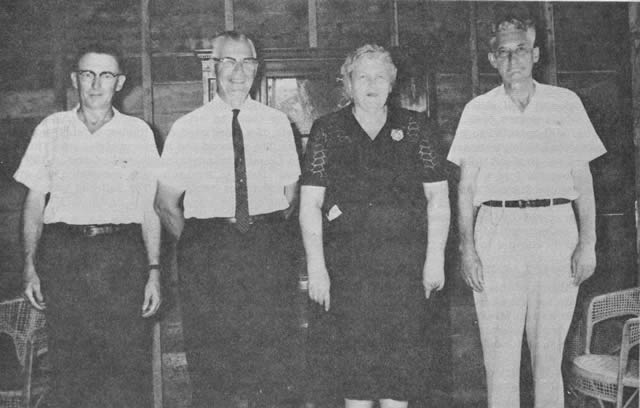
Photo courtesy Branson Beacon
OFFICERS for 1963-64: Elmo Ingenthron, re-elected
Secretary; Ralph D. McPherson, President; Frances McConkey, 1st Vice-President;
and I. M. Thompson, 2nd Vice-president. Not pictured is Dorothy Standlee, Treasurer.
Mr. McPherson, well-known educator, was superintendent of schools at Bradleyville,
Galena, and Forsyth for 33 years, 24 of those years at Forsyth. A graduate of
Southwest Missouri State College, he received the M.Ed. degree from the University
of Missouri. He now lives at Forsyth and Brown Branch. Miss McConkey, after
retiring as a teacher in Indiana, returned to her home in Forsyth, and has continued
teaching social studies and languages in the high schools at Forsyth and Hollister.
A dedicated churchwoman, she is also a leader in the Taneycomo Chapter of the
Daughters of the American Revolution. Mr. Thompson, prominent Branson businessman
and owner of the Thompson Insurance Agency, has the distinction of having lived
at Branson longer than any other resident. He was a member of the first graduating
class of Branson High School, and is well-known for his interest in local history.
Mr. Ingenthron. who is regarded as the founder of the White River Valley Historical
Society, lives on his farm near Kirbyville, and is Superintendent of Schools
for Taney County. Mrs. Standlee of Hollister is a teacher in the Branson Elementary
School. Leon Farrell, owner and publisher of the Branson Beacon, was elected
Director for Taney County, and Ruby Robins, co-owner and publisher of the Ozark
County Time, Gainesville, was re-elected Director for Ozark County.
[12]
Honorary Members
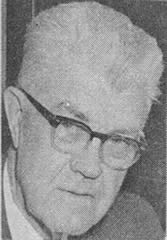 J. E. Curry
J. E. Curry |
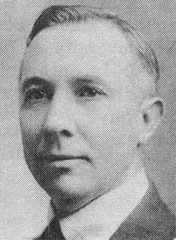 William E. Freeland
William E. Freeland |
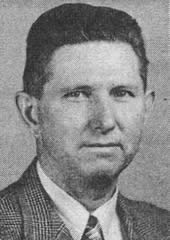 Coy Logan
Coy Logan |
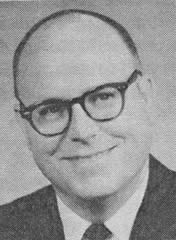 Leslie Brock
Leslie Brock |
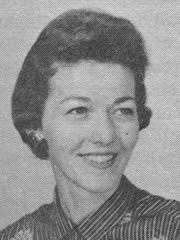 Dorothy Cummings
Dorothy Cummings |
SENATOR J. E. CURRY
Ava, Missouri
For his contributions in writing and preserving the history of Douglas County, Missouri, Senator J. E. Curry was elected an honorary member. Both he and Mr. Freeland have been very generous in providing our historical society with material which, but for their care, would have been irretrievably lost.
Mr. Curry is the publisher of the Douglas County Herald and has been with the newspaper since 1915.
He was born in Ozark County, Missouri, and moved to Douglas County when a small boy. His parents, George and Elizabeth (Frost) Curry, came from Tennessee. His father was a Baptist minister and also served his district with distinction as senator.
Mr. Curry graduated from Ava High School and attended the University of Missouri one year.
Active in government and civic affairs, he was a member of the Missouri Senate from 1944 to 1952 where he is remembered as a leader in programs to improve roads and schools in Missouri.
He was author of the proposed constitutional amendment known as the Curry road amendment, which would have increased the state gasoline tax 1 1/2c a gallon, and eliminated all city gasoline taxes. The increase would have been divided with 1/2c going to cities for streets improvements and 1c to the counties for constructing and improving rural roads. The amendment was opposed in the metropolitan areas and was defeated at the polls although it had been passed by the legislature. However, the proposed amendment led to a recognition of the rural road problem in Missouri. Representative Douglas Mahnkey, then a very able and influential member of the General Assembly, handled the Curry road amendment in the House and deserves, says Senator Curry, much credit for its adoption by the legislature.
The senator served on a special committee setup by Governor Smith for further study of the rural road problem. Out of the committee's deliberations came the ten-year program, adopted by the legislature, requiring the State Highway Department to take over, build and maintain a minimum of 100 miles of rural roads in each county within a period of ten years. The program was recently completed in all counties.
So the proposed Curry Constitutional Amendment, though defeated at the polls, did in reality result in a very important rural road program, and perhaps had a favorable effect on the recent adoption of an increase in the gasoline tax to 4c, dividing a portion of the increase with the various cities for street improvements, and rural roads throughout all the counties-the program now in effect on a permanent basis.
Mr. Curry has served as committeeman for both State and Douglas County Republican Committees, and was for many years on the Board of Education of Ava, and the Ava City Council. He is an ex-chairman and member of the board of the Ava Industrial Corporation. The senator is a Baptist, a Mason, a charter member and ex-chairman of the Lions Club, member of the Amite Club and is active in the Ava Chamber of Commerce.
He married Esther Curnutt and they have two children: Dr. Howard J. Curry, Ava, and James E. Curry, Jr., an attorney at Ava.
SENATOR WILLIAM E. FREELAND
Forsyth, Missouri
Elected to honorary membership for his contributions in preserving and writing local history was Senator William E. Freeland. Mr. Freeland has for many years made his strong sense of history felt by publishing in his newspapers his own and other people's articles on local and Missouri history.
The publisher of the Taney County Republican for many years, and more recently of the White River Leader, Mr. Freeland is now a counsellor and editor emeritus of both newspapers.
[13]
He was born January 5, 1879, in Howard City, Elk County, Kansas, while his parents were there temporarily. Their home was in Shelby County, Missouri. Mr. Freeland's ancestors were old Colonial families of Virginia. His great-grandfather, John Freeland, served in the Revolutionary War, as did other paternal and maternal ancestors. His mother's family, the Mayes and Howes from Virginia, came from Kentucky to Missouri about 1830.
Mr. Freeland attended rural schools in Shelby County and graduated from the Shelbina, Missouri, high school in 1898. He taught school three terms in rural Shelby County.
In January 1900, he entered the U. S. Indian Service at Chilocco, Oklahoma. He attended Kansas University one semester before returning to the Indian Service, Day School, Pine Ridge Agency in 1903. He went to the Brule Dakota Agency for a short time and then transferred to the Hopi Agency in Arizona in 1906. He remained there until 1912. From 1913 to 1916, he was at the San Juan Navajo Agency, Shiprock, New Mexico, and from 1916 to 1920 at the Kiowas, Comanche, Apache Agency at Anadarko, Oklahoma.
Mr. Freeland bought a farm in the McKinney Bend on White River in 1908, and bought the Taney County Republican in 1917. Since the government did not accept his resignation until 1920, his wife came to Taney County and took over the newspaper in the fall of 1919. He joined her in April 1920, and has been associated with the paper ever since.
Elected to the Missouri House of Representatives in 1922, he served twelve years, and is remembered as an untiring worker for those things he believed were good for the country. He was chairman or ranking member of the committee on education, and sponsored the equalization program for Missouri schools. He served as a member of the pre statute revision commission, 1927-1929, and the post- revision commission, 1928-1931. Mr. Freeland was majority leader of the House of Representatives in 1929. From 1931-1933, he was a member of the Committee on taxation and government reform, and sponsored a number of bills proposed by that Committee.
He was a member of the Missouri Senate from 1937 to 1941, and a member of the State Planning Board from 1942-1945.
Senator Freeland was president of the Missouri Press Association in 1942, and a year later received an award for distinguished service in journalism.
With the coming of Bull Shoals Dam, he bought the White River Leader, and moved the letter press plant to Branson. After the government settlement, he built an offset plant at Forsyth. He has given the letter press shop and building at Branson to The School of the Ozarks and has placed the two newspapers with the School in trust for the ultimate establishment of a School of Journalism.
Mr. Freeland was appointed to the Commission on Labor and Industrial Relations July 1, 1950, and he resigned from the commission in June 1957.
He met his wife, Minnie E. Freeland, in August 1900, and they
were married August 7, 1903. They have two children: Frieda Ingenthron, now
teaching at Hollister, and Maude Freeland, teaching on the staff of the University
of Missouri. Frieda has one son, William J. Ingenthron, whose wife is Janeth
Fisher Ingenthron. Their son is Robin F. Ingenthron. They have been with the
New Bedford Times in Massachusetts.
COY LOGAN
Berryville, Arkansas
For his writing and helping to preserve the history of Carroll County, Arkansas, and of the White River Valley, and for assisting the White River Valley Historical Society in many ways-serving as director as well as collecting and lending historical material, Mr. Coy Logan was elected to honorary membership.
Mr. Logan, 56, was born and reared in the Dry fork community in south Carroll County, Arkansas. He attended the rural schools which had terms of three to five months. A graduate of the Kingston High School, Madison County, he attended Arkansas Tech, and has the B.A. and M.A. degrees from the University of Arkansas. He taught for thirteen years, and has served twenty-two years as County Supervisor of Schools of Carroll County.
Mr. Logan is a Baptist and a Democrat. He is a member of the Arkansas Education Association, National Education Association, Phi Delta Kappa, board member of Educators and Professional Life Insurance Company of Arkansas, board member of Arkansas Educators Investment Corporation, and chairman of the North Arkansas Regional Library Board serving seven counties.
He is married to Cecil Clara Bohannan, and they have two children: Mrs. Laverne Elsey, a teacher at Granby, Missouri, and Arlis Logan, a civil engineer at Borger, Texas.
Mr. Logan became interested in local history through his grandmother, Malinda Newberry Logan, who told him Civil War stories he never forgot. His interest grew when he was in school at Russellville and his history professor, the late T. A. Dulaney, organized a history club. He has served as president of the Carroll County Historical Society and is presently serving as editor of its Quarterly publication. His main hobby with the society is to interview some of our senior citizens and get their life stories in writing and on tape with a tape recorder.
[14]
LESLIE BROCK
Point Lookout, Missouri
Elected for his outstanding contribution to the Society evidenced by his work, cooperation, and interest in publishing the Quarterly was Leslie Brock, who is supervisor of the J. M. McDonald Printing Department at The School of the Ozarks. In spite of a heavy regular schedule Mr. Brock has devoted afterhours and holidays to work toward improving the quality of the Quarterly.
He was born in Springfield, Missouri, twenty-seven years ago and attended Central High School in Springfield. After serving two years in the U.S. Navy in the South Pacific during World War II, he returned to Springfield and worked in the printing industry. In 1956 he and his family moved to California, where he was employed in the printing department at Hughes Aircraft.
He married Velta Willoughby of Nixa, and they have four children: Dee Ann, 19, a college sophomore at The School of the Ozarks; Donna, 15; Randy, 10; and Lori, 6, students at Hollister School.
Mr. Brock participates in Cub Scouting, and is an Elder of Williams Chapel at The School of the Ozarks.
DOROTHY CUMMINGS
Branson, Missouri
Born at Protem, Missouri, the daughter of Albert H. and Ruth (Collins) Stacey, Dorothy Cummings attended schools at Cedar Creek, Forsyth, and Bran- son. She is a graduate of Southwest Missouri State College, and also attended Wittenberg University in Ohio, Drury College, the University of Missouri, and the University of Guadalajara, Mexico.
She worked at the Security Bank of Branson, and Winters National Bank and Trust Company, Dayton, Ohio; was a civilian employee of the Department of the Air Force in Nebraska, Colorado, and Germany, and taught school at Branson.
She is married to Lt. Col. Albert D. Cummings, USAF, retired, who is a teacher at The School of the Ozarks. She is an Episcopalian, and is a member of the Business and Professional Women's Club and the Order of the Eastern Star.
Her interest in local history began several years ago when she read Walter F. Lackey's History of Newton County, Arkansas. At present, she is editor of the Society's Quarterly publication.
(Our thanks to Rachel Church, Forsyth, and Claude Hibbard, Ava, for their help in writing about the honorary members).
Financial Report of
THE WHITE RIVER VALLEY HISTORICAL SOCIETY
for the year ending June 30, 1963
Balance at end of year, June 30, 1962 $122.85
Deposits from memberships, renewals, sale of Quarterlies, and donations for year ending June 30, 1963 729.87TOTAL $852.72
The following bills approved and paid during year ending June 30, 1963
Treasurer, postage $ 4.00Canote Drug Store, refund on Quarterlies 3.60
American Assoc. of State and Local History, subscription and publications 12.23
Printing 288.32
Postage, mailing Quarterly 57.54
Mail permit 45.00
Postage, mailing Quarterly 31.78
Office supplies 14.41
Gen. Serv. Adm., copy 1860 census 20.00
Refreshments, spring meeting 2.26
Postage, mailing Quarterly 49.95
Secy of State, fee for incorporation 10.00
Recording Certificate of Incorporation 4.00
TOTAL EXPENDITURES $543.09
Balance account, Peoples Bank of Branson $309.63
s/ Dorothy Standlee, Treasurer
[15]
This volume: Next Article | Table of Contents | Other Issues
Other Volumes | Keyword Search | White River Valley Quarterly Home | Local History Home
Copyright © White River Valley Historical Quarterly

